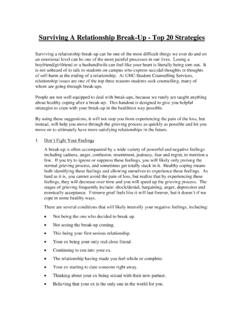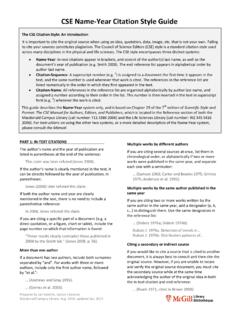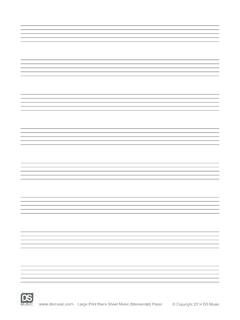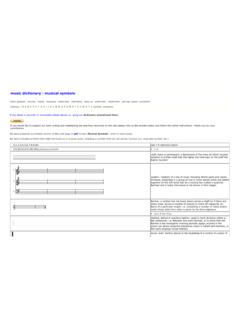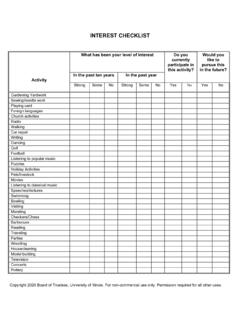Transcription of Citing Music Resources - McGill University
1 Citing Music Resources Using Chicago Style (Bibliography Format). Based on The Chicago Manual of Style, 16th ed. and Style Sheet 2008 by Prof. Julie Cumming Bibliographic and reference forms must be consistent and must include all the necessary information. The following style sheet is based on The Chicago Manual of Style, 16th ed. (REF Z253 U69 2010;. The Chicago Manual of Style Online). Bibliography Format In a bibliographic entry the elements (author, title, publication information, etc.) are separated by a period and a single space. The first-listed author's name is inverted (last name first). The spelling, hyphenation, and punctuation in the original title found on the item should be preserved, with some exceptions (Chicago ). English-language titles and subtitles are capitalized headline-style (Chicago ), while titles in other languages are usually capitalized sentence-style (Chicago ).
2 Titles of larger works ( , books and journals) are italicized; and titles of smaller works ( , chapters, articles) are enclosed in quotation marks. Note that commas and periods go inside the quotation marks. Noun forms such as editor, translator, volume, and edition are abbreviated, but verb forms such as edited by and translated by are spelled out (Chicago ). If a work is a reprint, that information may be included, particularly the date. For more information about Citing reprints, see Chicago Some bibliographic information may be difficult to determine from a document. To clarify these details, check the library catalogue record for the document. If no date or place of publication can be determined, the abbreviations and may be substituted. Estimates of dates and places of publication may be placed in square brackets and followed by a question mark.
3 Boston, Oliver Ditson, : Insel-Verlag, 1949. Edinburgh, [1750?] [Lake Bluff, IL?]: Vliet & Edwards, 1890. Bibliographic entries are indented after the first line, called a hanging indent. HINT: To do this in Microsoft Word, select the entries and press CTRL-T. The entries should be alphabetized by author. BOOK (Chicago ). When Citing books one normally gives the author, title, publisher location, publisher name, and year of publication. If the book was accessed online, include a URL followed by a period. Rosen, Charles. The Classical Style: Haydn, Mozart, Beethoven. New York: Norton, 1972. Winchester, Barbara, and Kay Dunlap. Vocal Chamber Music : A Performers Guide. New York: Routledge, 2008. Prepared by staff of the Marvin Duchow Music Library, McGill University Revised September 2012. ARTICLE / CHAPTER IN EDITED BOOK (Chicago ).
4 When Citing an article in a book one normally gives the author, article title, book title, editor, page range, publisher location, publisher name, and year of publication. Precede the title of the book with In. Chase, Gilbert. Musicology, History, and Anthropology: Current Thoughts. In Current Thoughts in Musicology, edited by John W. Grubbs, 231-246. Austin: University of Texas Press, 1976. GROVE ARTICLE (Chicago ). Articles in The New Grove and its offshoots (The New Grove Dictionary of Musical Instruments, The New Grove Dictionary of Opera, etc.) are cited by author of the article. The author's name is found at the very end of the print Grove article, after the bibliography; or on the top left of the first page of the online version. Online: Winter, Robert, Maurice Brown, and Eric Sams. Schubert, Franz.
5 In Grove Music Online. Oxford Music Online. Accessed January 1, 2011. Print: Winter, Robert, Maurice Brown, and Eric Sams. Schubert, Franz. In The New Grove Dictionary of Music and Musicians, edited by Stanley Sadie and John Tyrell, vol. 22: 655-729. London: MacMillan, 2001. PERIODICAL ARTICLE (Chicago ). For periodicals ( journals and magazines) one normally gives the author, article title, journal title, volume, issue number, year, and page numbers. Convert roman numerals into Arabic numbers for the volume numbers. If the article was accessed online, include a URL. Everist, Mark. Grand Opera Petit Opera: Parisian Opera and Ballet from the Restoration to the Second Empire. 19th-Century Music 33, no. 3 (2010): 195-231. Price, Curtis. Italian Opera and Arson in Late Eighteenth-Century London. Journal of the American Musicological Society 42 (1989): 55-107.
6 REVIEW (Chicago ). Citations of reviews include the following elements, if present: name of reviewer; title of the review; the words Review of, followed by the name of the work reviewed and its author/composer/performer;. Location and date (in the case of a performance); and the listing of the periodical in which the review appeared. Unsigned reviews are alphabetized by the name of the periodical in which they appear. Diehl, Matt. Metallica, Slayer Make Desert Roar at Epic Metal Summit. Review of April 23, 2011, "Big 4" concert in Indio, California. Rolling Stone, May 26, 2011, 22. Prepared by staff of the Marvin Duchow Music Library, McGill University Revised September 2012. Everist, Mark. Review of The Oxford History of Western Music , by Richard Taruskin. Journal of the American Musicological Society 62 (2009): 699-720.
7 THESIS / DISSERTATION (Chicago ). The title of a thesis or dissertation is placed in quotation marks and not italicized, since this type of document is not published. List the type of thesis, the degree-granting institution, and the year of submission after the title. Add a URL if the document is consulted online. If it comes from a database such as Proquest, replace the URL with the name of the database and an identifying number supplied by the database. Cumming, Julie. Concord Out of Discord: Occasional Motets of the Early Quattrocento. dissertation, University of California, Berkeley, 1987. Proquest 8813839. SCORE (Chicago ). Many scores are treated just like books, though often with the addition of an editor. If in addition to an author there are names of editors or translators, they will appear after the title preceded by Edited by or Translated by (Chicago ).
8 If the score was accessed online, add the URL (followed by a period) at the end of the citation (as in the first example) (Chicago ). Krenek, Ernst. Dream Sequence, op. 224. Vienna: Universal Edition, 1977. Shostakovich, Dimitri. String Quartet No. 8, Opus 110. Edited by Hans Sikorski. New York: G. Schirmer, 1961. SCORE OF A WORK PUBLISHED WITHIN A SERIES, COLLECTION, OR COMPLETE. WORKS EDITION. Citing a specific piece within a score is treated as a chapter in a book, or titled part of a book. The composer's name is followed by the part, followed by In, followed by the title of the book or score (Chicago ). When Citing a work from a series or complete works, indicate the editor, page range, series, volume, and date. If a single volume of a multivolume work is cited, only the date of that volume should appear.
9 If an entire multivolume, multiyear work is cited, give the range of dates. If the work has not been completed, give the date of the first volume followed by a dash (Chicago, ). Guastavino, Carlos. Pampamapa. In The Art Song in Latin America: Selected Works by Twentieth- Century Composers, edited by Kathleen L .Wilson with IPA and Diction sections by Arden Hopkin, 35-8. Stuyvesant, NY: Pendragon, 1998. Schubert, Franz. Fantasie. In Klavierst cke Klaviervariationen, 42-62. Munich: G. Henle Verlag, 1992. Prepared by staff of the Marvin Duchow Music Library, McGill University Revised September 2012. Schubert, Franz. Fantasie in C. In Werke f r Klavier zu zwei H nden, Band 4 Klavierst cke I, edited by David Goldberg. Neue Ausgabe s mtlicher Werke, vol. 7, no. 2, 83-97. Kassel: B renreiter, 1988. SOUND RECORDING (Chicago ).
10 Cite the recording by the element you are referring to: composer or performer. For online recordings, add a URL (followed by a period) to the end of the citation (Chicago ). Composer. Title of Recording. Performer/Ensemble. Conductor. Label Label number, date, format. Bernstein, Leonard. Fancy Free / Symphony No. 2 The Age of Anxiety / Overture from Candide.. Bournemouth Symphony Orchestra. Andrew Litton. Virgin Classics 0724356111950, 1990. Glass, Philip. Einstein on the Beach. Philip Glass Ensemble. Michael Riesman. Electra Nonesuch 793232, 1993, 3 compact discs. VIDEO RECORDING (Chicago ). Video recordings are cited in a manner very similar to sound recordings, except for the inclusion of publication information as required for books (place of publication, publisher, and date). The label number is not required.
